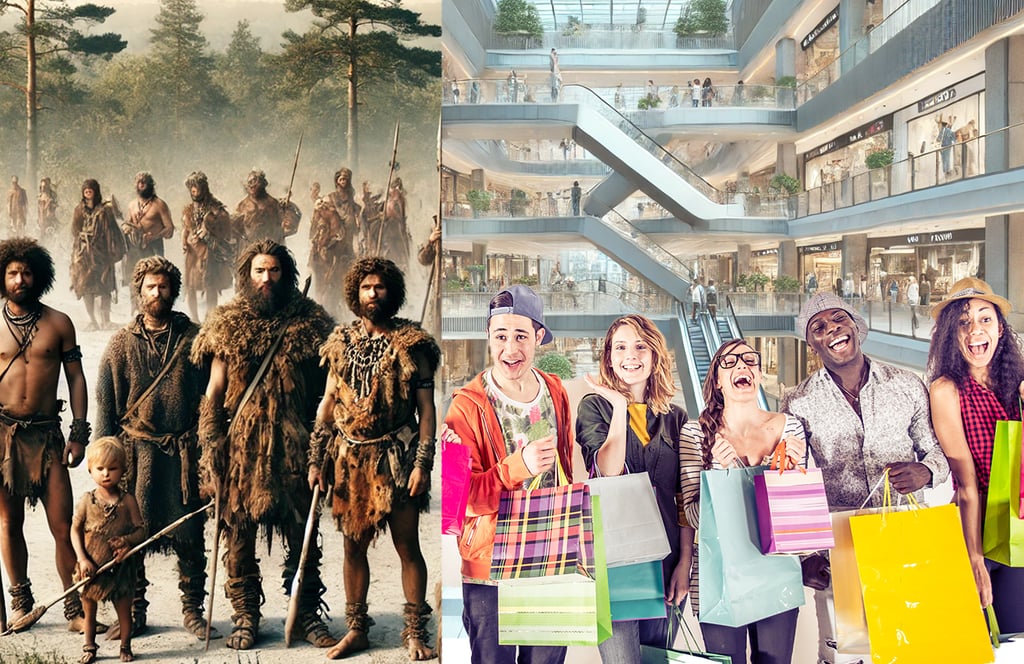From Survival to Consumerism: Brief History of Our Relationship with Stuff
Consumerism, the act of acquiring goods and services in excess of one’s basic needs, has evolved significantly over centuries. Initially, a means of survival and trade, consumerism has developed into a complex cultural phenomenon, influenced by industrialization, advertising, globalization, and now, sustainability. Here’s a look at how consumerism developed through different historical periods, each leaving its own mark on how we shop, what we value, and how we express ourselves through the things we buy.
CONSUMERISMHISTORY
Genya
5/8/20243 min read


Consumerism, the act of acquiring goods and services in excess of one’s basic needs, has evolved significantly over centuries. Initially, a means of survival and trade, consumerism has developed into a complex cultural phenomenon, influenced by industrialization, advertising, globalization, and now, sustainability. Here’s a look at how consumerism developed through different historical periods, each leaving its own mark on how we shop, what we value, and how we express ourselves through the things we buy.
1. Origins in Trade and Exchange (Pre-16th Century)
Before consumerism, trade existed to meet basic needs and promote cultural exchange. Ancient civilizations traded goods like salt, spices, and textiles, each carrying value not only as commodities but as symbols of status. Silk and spices from Asia and Africa, for example, were highly valued in Europe. Wealthy elites began to acquire goods beyond necessities, laying the foundation for consumerism by linking goods to social status.
2. The Age of Exploration and Luxury Goods (16th-17th Century)
The 16th century marked the beginning of global consumerism with the European Age of Exploration. Exploration opened up new trade routes, allowing merchants to bring exotic goods like sugar, tea, tobacco, and coffee back to Europe. These goods quickly became symbols of wealth, only accessible to the affluent. By the late 1600s, popular items included tea and porcelain from China, spices from India, and luxurious textiles like silk. Consumerism became closely associated with displaying wealth and sophistication.
3. Industrial Revolution and Mass Production (18th-19th Century)
The Industrial Revolution transformed consumerism by making goods affordable and accessible to a broader public. Mass production of textiles, soap, glass, and metal goods allowed for cheaper, uniform products. The emergence of department stores, such as Le Bon Marché in Paris and Macy’s in New York, encouraged browsing and buying for pleasure rather than need. Shopping was no longer just a task; it became a leisure activity. People could now purchase items like ready-made clothing, decorative glassware, and household goods, sparking the rise of a consumer culture.
4. Consumerism and Advertising Boom (Early 20th Century)
By the 1920s, consumerism had woven itself into the fabric of Western culture. This era saw the birth of modern advertising, as companies learned to market products through radio, print, and, later, television. Advertising portrayed goods not merely as functional but as transformative for lifestyle and status. Automobiles, appliances, and processed foods became household staples, while brands like Coca-Cola and Ford became household names. Consumer goods now promised happiness, convenience, and social status, marking the start of consumerism as self-expression.
5. Post-War Consumerism and Suburban Expansion (1945-1970)
After World War II, consumerism reached new heights, especially in the United States. A post-war economic boom brought increased wages and the rise of the middle class, sparking a mass move to suburban living and a demand for home goods. Household items like washing machines, refrigerators, and televisions became symbols of the American Dream. Suburban malls and car culture gave rise to a shopping-centric lifestyle. By the late 1950s, consumerism became tied to patriotism and a sense of post-war prosperity, fueling an unprecedented era of material acquisition.
6. Global Brands and Pop Culture (1980s-2000s)
The 1980s marked a major shift in consumerism as multinational brands like Nike, Apple, and McDonald’s expanded globally. Globalization, mass media, and celebrity endorsements pushed brand loyalty and the desire for status-symbol goods. In this era, goods became emblems of identity, with popular items ranging from designer jeans and Walkmans to branded sneakers and electronics. The internet and e-commerce in the late 1990s allowed consumerism to scale globally, creating more opportunities for instant purchasing and connecting with brands worldwide.
7. Digital Consumerism and the Rise of Conscious Shopping (2010s-Present)
In the 21st century, online shopping redefined consumerism. Digital platforms allowed for a seamless buying experience, fueled by social media, targeted ads, and influencer marketing. Smartphones, tech gadgets, and fashion became more accessible than ever, driving a culture of immediacy and “fast fashion.” However, as environmental concerns grew, a new wave of “conscious consumerism” emerged. People began to prioritize sustainable brands, secondhand goods, and ethical shopping practices, challenging traditional consumerism. The focus shifted from quantity to quality, with more consumers looking for products that reflect personal values.
The Shifting Meaning of Consumerism
What started as a way to signal status and security has become a means of self-expression, convenience, and increasingly, a reflection of values. The modern consumer is more aware, balancing desires with ethics and environmental considerations. While consumerism has faced criticism for promoting materialism, it has also evolved into a powerful way for individuals to express identity and beliefs, whether through technology, sustainable fashion, or experiences over objects.
As consumerism continues to evolve, our approach to buying will likely shift further, blending our historical desire for goods with a responsible and mindful outlook.
